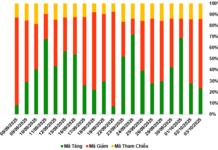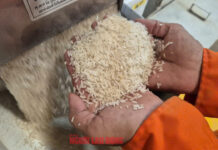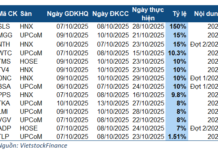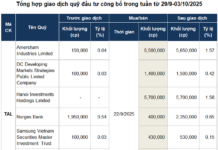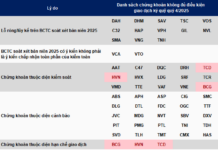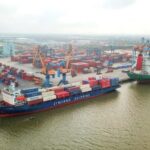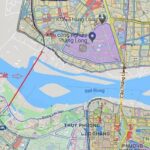The Inland Waterways Department under the Ministry of Transport chaired a meeting with agencies, including the Inland Waterways Department (Ministry of Transport), Haiphong Maritime Port Authority, Vung Tau Maritime Port Authority, and Gemadept Corporation, to discuss the proposal of developing a model waterway route connecting the Mekong Delta provinces to Cai Mep, via Dong Nai, Cat Lai, and back to the Mekong Delta.
INTER-REGIONAL CONNECTIVITY VIA WATERWAYS, REDUCING LOGISTICS COSTS
This inland waterway route was first mentioned almost two years ago as a means to facilitate inter-regional connectivity via waterways between logistics hubs in the region, such as Can Tho, Cai Mep- Thi Vai, and Cat Lai. The implementation of this route is expected to reduce logistics costs, shorten transportation time, lower product prices, and enhance the competitiveness of goods.
The Mekong Delta is the country’s agricultural and marine product hub, contributing over 60% of rice production and 90% of rice exports. It also accounts for 37.5% of the total area of fruit trees in the country, with an annual output of about 3.8 million tons, making up more than 70% of the country’s fruit output. Additionally, the region contributes approximately 52% of captured seafood and nearly 67% of aquaculture production, while also accounting for 65% of the value of export turnover.
Gemadept Corporation has been studying the feasibility of this model route, connecting the Mekong Delta with the Cai Mep and Cat Lai areas via a coastal route and the Quan Chanh Bo channel. One of the main challenges for this waterway route is finding suitable vessels due to the specific hydrographic characteristics of the Western Mekong Delta, which includes a high sediment load. This makes it difficult to find vessels that can navigate the route efficiently, as smaller ships may not have sufficient cargo capacity, and larger container ships may struggle with the narrow and shallow rivers.
According to Gemadept, the market currently only offers SI-type vessels, and there is a lack of small container ships. (The SB, SI, and SII regions are inland waterway transport routes along the coastal areas, from the shore to islands, connecting islands, from the river mouth to the sea, and back to the mainland; inlets, bays, rivers, canals, and other inland waterways announced by the Ministry of Transport, with management and exploitation organized by the Ministry of Transport. These routes are within 12 nautical miles of the shore or a place of refuge – Editor’s note).
As a solution, the operating unit is proposing to the Ministry of Transport that they coordinate with the Vietnam Register and other relevant agencies to work with shipbuilders to design and construct SB barges suitable for this model route. If approved by the Ministry, SB barges will be allowed to operate exclusively on the Mekong Delta-Cai Mep-Dong Nai-Cat Lai (Ho Chi Minh City) route without the need for tugboats or pilots, adhering to inland waterway transport standards. Gemadept is also expediting the design and construction of new vessels dedicated to this inland waterway route.
Regarding the issue of sediment accumulation along the route, the Can Tho Maritime Port Authority suggested that, for the time being, ships with appropriate drafts should be tested, and then the channel could be dredged to accommodate larger vessels. Meanwhile, the leader of the Transport Department suggested that during the trial period, sea-going vessels or sea barges with suitable characteristics could be utilized, and it may also be possible to lease foreign ships for testing purposes.
AN IDEA FIRST PROPOSED TWO YEARS AGO
Previously, in late September 2022, the Vietnam Maritime Agent and Broker Association (Visaba) proposed establishing a waterway transport route connecting the Mekong Delta with the deep-water port of Cai Mep (Ba Ria-Vung Tau) and Cat Lai Port (Ho Chi Minh City) via the Quan Chanh Bo channel.
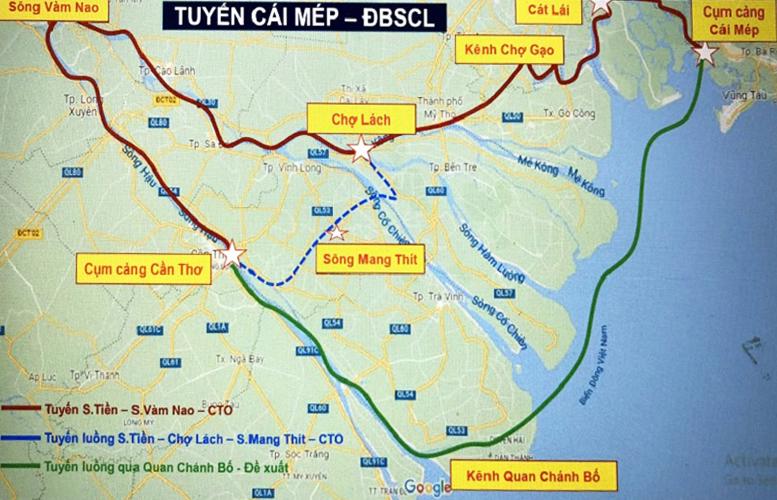
According to Visaba’s analysis, there are currently two waterway transport routes connecting the Can Tho port cluster to Cai Mep and Ho Chi Minh City, mainly following the Tien River – Vam Nao River route, with a total route length of about 367 km, and the Tien River – Cho Lach – Mang Thit River route, with a length of about 235 km. The transportation cost for these routes is approximately 7,000,000 VND/TEU.
In contrast, the proposed new route, connecting the Mekong Delta region with the deep-water port of Cai Mep and Cat Lai Port via the Quan Chanh Bo channel, would shorten the total route length to around 200 km. The transportation cost for this route is estimated at 3,000,000 VND/TEU. In addition to reducing transportation costs and relieving pressure on road transport, this model inland waterway route is expected to significantly reduce logistics costs for businesses, with preliminary calculations estimating a reduction of 60-70%.
A separate report from the same period, the “Mekong Delta Annual Economic Report 2022” by the Vietnam Chamber of Commerce and Industry (VCCI), revealed that the Mekong Delta has 101 inland waterway transport routes along rivers, canals, and creeks, totaling 3,186.3 km in length. However, the budget allocated for the waterway transport sector decreased from 2-3% of the total transport infrastructure investment budget during the 2011-2015 period to only 1.2% in the 2016-2020 period. Despite its significance, the Mekong Delta still lacks a proper seaport.
The VCCI report also highlighted that transportation costs account for 30% of the product’s price. Furthermore, while road transport is faster than waterway transport, it has lower cargo capacity per trip and higher transportation costs. Road infrastructure is also more susceptible to damage. For example, the journey from Can Tho port to Cat Lai port (Ho Chi Minh City) takes 18 hours by waterway and 36 hours to Cai Mep port, while the road trip from Can Tho to Cat Lai takes 5 hours and to Cai Mep, approximately 8 hours.
In September 2022, the Inland Waterways Department of Vietnam proposed selecting the first model route from the Haiphong seaport area to the ICDs located deep in the mainland. The route starts from Lach Huyen Port (Haiphong) via Cai Trap canal – Cam River – Han River – Kinh Thay River – Thai Binh River – Duong River and finally delivers containers at Tan Cang Que Vo ICD (Bac Ninh). The total length of the transport route is 115 km, with a route grade of I and II.
Vietnam ready to welcome record international visitors
In January of this year, Vietnam welcomed over 1.5 million international visitors, the highest number since the country reopened its tourism in March 2022.
Urgent Momentum on the Construction Site of the Hau River Bridge
In the scorching heat and gusty wind of the southwestern region in the days leading up to the 2024 Lunar New Year, there is a bustling construction site not far from the beach. Over 300 dedicated workers and staff are diligently working on the construction of the Dai Ngai Bridge, which will soon connect the two banks of the Hau River.
Project “Quality High-Yield Rice Cultivation” – The Big Game and the 10 Principles
On the morning of January 5th, in Kiên Giang province, Deputy Prime Minister Trần Lưu Quang presided over a conference to implement the Sustainable Development Project for 1 million hectares of high-quality, low-emission rice cultivation linked to green growth in the Mekong Delta region by 2030.


